Related Research Articles
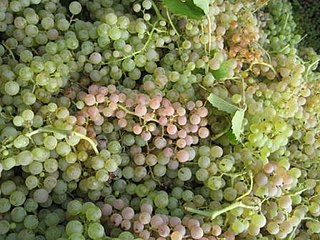
Garganega is a variety of white Italian wine grape widely grown in the Veneto region of North East Italy, particularly in the provinces of Verona and Vicenza. It is Italy's 6th most widely planted white grape. It forms the basis of Venetian white wine Soave and is also a major portion of the blend used to make Gambellara.
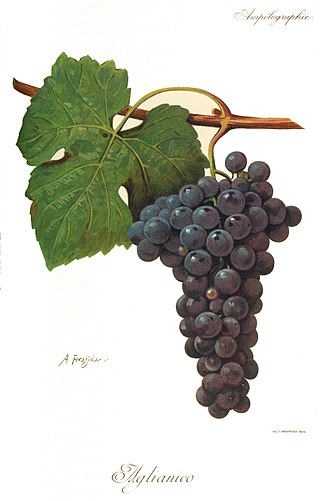
Aglianico is a black grape grown in the southern regions of Italy, mostly Basilicata and Campania. It is considered with Sangiovese and Nebbiolo to be one of the three greatest Italian varieties. Aglianico is sometimes called "The Barolo of the South" due to its ability to produce highly refined, complex fine wines like the famous wine from Piedmont, Barolo.

Verdicchio is a white Italian wine grape variety grown primarily in the Marche region of central Italy. The name Verdicchio derives from verde and refers to the slight green/yellow hue that wines made from the grape can have.

Vermentino is a light-skinned wine grape variety, primarily found in Italian wine. It is widely planted in both Sardinia and Liguria, to some extent in Corsica, in Piedmont under the name Favorita, and in increasing amounts in Languedoc-Roussillon. The leaves are dark green and pentagonal. The grapes are amber-yellow and hang in pyramidal bunches. The vines are often grown on slopes facing the sea where they can benefit from the additional reflected light. The Vitis International Variety Catalogue now gives Italy as its origin.
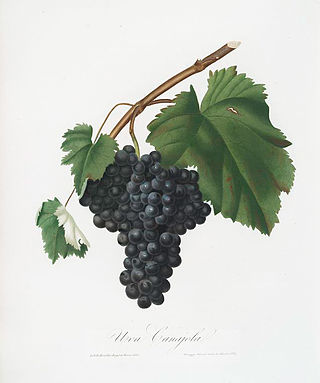
Canaiolo is a red Italian wine grape grown through Central Italy but is most noted in Tuscany. Other regions with plantings of Canaiolo include Lazio, Marche and Sardegna. In Umbria a white berried mutation known as Canaiolo bianco exists. Together with Sangiovese and Colorino it is often used to create Chianti wine and is an important but secondary component of Vino Nobile di Montepulciano. In the history of Chianti it has been a key component blend and during the 18th century may have been the primarily grape used in higher percentage than Sangiovese. Part of its popularity may have been the grape's ability to partially dry out without rotting for use in the governo method of prolonging fermentation. In the 19th century, the Chianti recipe of Bettino Ricasoli called for Canaiolo to play a supporting role to Sangiovese, adding fruitiness and softening tannins without detracting from the wine's aromas. In the aftermath of the phylloxera epidemic, the Canaiolo vines did not take well to grafting onto new American rootstock and the grape began to steadily fall out of favor. As of 2006, total plantings of Canaiolo throughout Italy dropped to under 7,410 acres. Today there are renewed efforts by Tuscan winemakers to find better clonal selections and re-introduce the variety into popular usage.

Torrontés is a white grape variety, mostly produced and known in Argentina, producing fresh, aromatic wines with moderate acidity, smooth texture and mouthfeel as well as distinctive peach and apricot aromas on the nose. Three Torrontés varieties exist in Argentina: Torrontés Riojano, the most common, Torrontés Sanjuanino, and Torrontés Mendocino. It is primarily Torrontés Riojano that has received attention for the quality of its wines, and is the variety used for most Argentine wines simply labeled Torrontés.
Greco is an Italian wine grape that may be of Greek origin. The name relates to both white and black grape varieties. While there is more land area dedicated to Greco nero, the Greco bianco is the grape most commonly referred to by "Greco". In the Campania region it is used to produce the denominazione di origine controllata e garantita (DOCG) wine Greco di Tufo. In Calabria, it is used to make the denominazione di origine controllata (DOC) wine Greco di Bianco. The name "Greco" is sometimes used as a synonym for several varieties of supposed Greek origins-most notably Trebbiano.

Fiano is a white Italian wine grape variety that is grown primarily in the Campania region of southern Italy and on the island of Sicily. In Campania, this fairly strong flavored white wine grape is particularly noted around Avellino where the Denominazione di origine controllata e Garantita (DOCG) wine of Fiano di Avellino is produced. The grape has a long history in the Campanian region and is believed to have been the grape behind the ancient Roman wine Apianum. Even today, the name Apianum is permitted to appear on wine labels of the DOCG wine Fiano di Avellino.
Verdeca is a white Italian wine grape variety that is primarily grown in Apulia in southern Italy where ampelographers believe that the grape may have originated. In Apulia, it is one of the main grapes in the Denominazione di origine controllata wines of Locorotondo DOC and Martina Franca DOC along with Bianco d'Alessano. In Campania, it is grown on the slopes of Mount Vesuvius where it used as a blending variety with Falanghina, Coda di volpe and Greco in both the white wines and the sweet dessert wine of the region, Lacryma Christi. It is also a minor component used in the some vermouth production.

Grechetto or Grechetto bianco is a white Italian wine grape variety of Greek origins. The grape is planted throughout central Italy, particularly in the Umbria region where it is used in the Denominazione di origine controllata (DOC) wine Orvieto and Denominazione di origine controllata (DOC) wine Valdichiana Toscana. It is primarily a blending grape, though some varietal wine is also produced. Grechetto is commonly blended with Chardonnay, Malvasia, Trebbiano and Verdello. The grape's thick skin provides good resistance to downy mildew which can attack the grape late in the harvest season. This makes Grechetto a suitable blending grape in the production of Vin Santo.
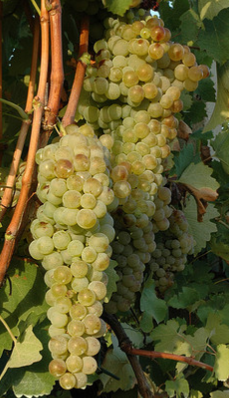
Albana is a white Italian wine grape planted primarily in the Emilia-Romagna region.

Catarratto is a white Italian wine grape planted primarily in Sicily where it is the most widely planted grape. Catarratto can make full bodied wines with lemon notes. In the Etna DOC, the grape is often blended with Minella bianca and Carricante.
Erbaluce or Erbaluce bianca is a white Italian wine grape grown primarily in the Piedmont region around Caluso, in Canavese. In addition to dry table wines, it is used to make sweet wines with deep golden coloring, such as passito. The grape has a long history in the Piedmont region, with the first written record dating to 1606, and most likely originated in the alpine hills of northern Piedmont.
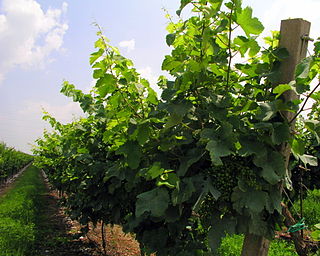
Glera is a white variety of grape of Italian origin, possibly from the namesake village, Prosecco. The variety was formerly mostly referred to as Prosecco, but in the EU was renamed "Glera" in 2009 to make room for the protection of "Prosecco" as the name of the Italian geographically-protected wine.
Bellone is a white Italian wine grape variety that wine historians believed was cultivated in Roman times. By 1990, nearly 3,000 hectares of the variety was still being cultivated and eligible to be blended in the wines of several Latium Denominazione di origine controllatas (DOCs). According to wine expert Jancis Robinson, Bellone produces a juicy white wine.

Coda di Volpe is a white Italian wine grape variety that has been historically grown in the Campania region around the town of Naples. It is often confused with another white Italian wine grape, Emilia, that share many of the same synonyms as Coda di Volpe.
Listán Prieto is a red grape variety that is believed to be originated from the Castilla-La Mancha region in Spain. Listán Prieto has disappeared from Spain mainland, but there are still 29 ha planted on the Canary Islands in 2008.
Maceratino is a white Italian wine grape variety that is grown predominantly in the Marche along the Adriatic coast of Italy. Ampelographers believe the grape may have some relation to Greco and Verdicchio, as evidence by the several overlapping synonyms, but no definitive link has been proven. For most of the 20th century, and into the 21st century, plantings of Maceratino have been declining and becoming increasingly rare.
Mantonico bianco is a white Italian wine grape variety that is grown in the Calabria region of southern Italy. Ampelographers believe that the grape is likely of Greek origins and was transported to southern Italy by ancient Greek settlers. Though the variety has a long history in Calabria, its numbers have been slowly declining with 1100 hectares/2700 acres planted in the region by the end of the 20th century.
Rovello bianco or Greco Muscio is a white Italian wine grape variety that is grown in the Campania region of southern Italy. While the grape has been described in wine literature since 1875, the variety was on the verge of extinction until a collaboration by the University of Naples Federico II and University of Palermo along with a local wine grower in Taurasi help revive the variety with new plantings in 2003.
References
- ↑ Robinson, Jancis (1996). Jancis Robinson's Guide to Wine Grapes . Oxford University Press, p. 25. ISBN 0-19-860098-4.
- ↑ J. Robinson (ed.). The Oxford Companion to Wine, third edition. Oxford University Press 2006, p. 326. ISBN 0-19-860990-6.
- ↑ COSTANTINI, L.; MONACO, A.; VOUILLAMOZ, J.F.; FORLANI, M.; GRANDO, M.S. (2005). "Genetic relationships among local Vitis vinifera cultivars from Campania (Italy)" (PDF). Vitis. 44: 25–34. Archived from the original (PDF) on 5 March 2016. Retrieved 27 November 2016.